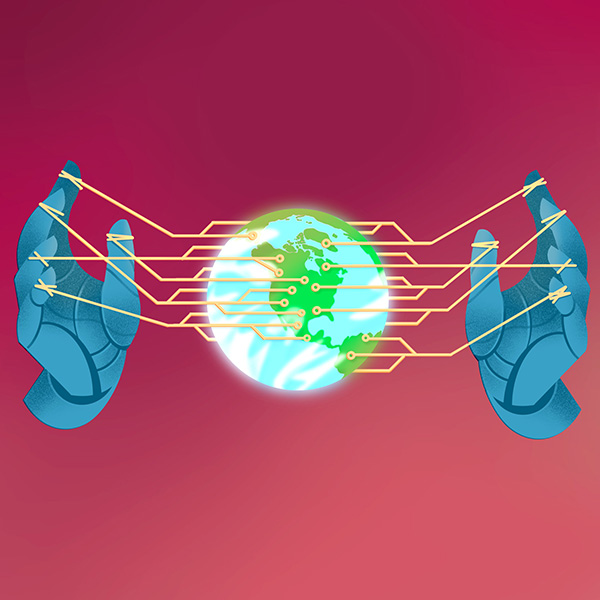What do MARS (the McGill Arctic Research Station) and Mars (the red planet) have in common? The Answer: Wayne Pollard. For almost 40 years, Pollard has carried out pioneering work in exploring Arctic waters, from perennial springs to permafrost and ground ice. His research has enhanced our understanding of geohydrology in polar deserts in the Arctic and Antarctica, tracked the impact of climate change on Canada’s northern landscapes, and supported scientific investigations of Mars and other planets.
This fall, Pollard received two significant career-recognition awards: in November the Royal Canadian Geographic Society awarded him the Martin Bergmann Medal for Arctic Leadership and Science, and in December he won the Weston Family Prize for Lifetime Achievement in Northern Research. “It’s been a good fall! Receiving the Weston award, the highest honour for a northern scientist in Canada, is incredible,” Pollard says.
The trajectory which led Pollard to the Arctic began when he was a boy growing up near Toronto. “The north held a fascination for me, and stories about Arctic exploration – the Franklin expedition, Henry Hudson, Roald Amundson – and even the colourful characters of the Klondike gold rush really captured my imagination,” he says. “But if you asked me when I was a high school student about my perfect job, it wouldn’t come close to describing how much I enjoy the job I’ve got now.”
Pollard joined McGill’s Department of Geography in 1988, and two years later became the director of MARS, the only permanent human settlement on Axel Heiberg Island in Canada’s high Arctic.
Near the station was a perennial spring, flowing year-round despite the frigid conditions. While that spring had been documented in 1960, Pollard then discovered six more springs. As this phenomenon had not been studied, Pollard launched a systematic analysis, revealing that the springs are connected to an unusual geological feature of the island: a layer of salt deep within its geological sequence mixes with groundwater, lowering the water’s freezing point and enabling the resulting springs to flow year-round. His research also described the impact of these salty waters on aspects of the local geomorphology, including salt deposits on the ground surface that revealed the presence of springs.
This research captured the attention of NASA, as well as the Canadian Space Agency and the SETI Institute (all have hired some of Pollard’s former graduate students). “These agencies see perennial springs as possible analogues for ancient groundwater systems we could find on Mars,” he explains. “And the fact that there is water under such cold conditions also suggests the possibility of life.” Pursuing this idea, Pollard and McGill colleague Lyle White, from the Department of Natural Resources, have collaborated in research into microbial life in these springs.
Another stream of Pollard’s research focuses on ice-rich permafrost; a recent publication drew on 30 years of documentation in the Eureka Sound lowlands in Nunavut, showing unique erosion patterns creating unusual horse-shoe shaped “slumps” in the landscape.
“We’ve been working to separate the normal changes of the permafrost landscape from changes caused by humans, while avoiding the alarmist reaction we see in many headlines. We’ve just come out of a glaciation, in existence until about 10,000 years ago, and as glaciers retreated, permafrost formed. This landscape evolves naturally and our research has demonstrated that some erosional features are 500 years old, going on independently of anthropogenic climate change,” he explains.
“There is also an interaction between natural and anthropogenic influences, as warm summers mean more active erosion, so anthropogenic climate change isn’t necessarily creating all the erosion, but is likely increasing its impact and the speed at which it takes place.” This body of research not only enhances our understanding of the permafrost that covers almost 50 per cent of Canada, but also of the impact that erosion could have on northern communities and development.
Ground ice isn’t visually evident, so Pollard developed non-invasive geophysical tools such as ground-penetrating radar to identify permafrost ground ice – innovations which then led to international collaborations to map ground ice conditions in Antarctica. His suite of geophysical tools have also intrigued space researchers, and he has worked with the CSA to adapt ground-penetrating radar for use on a Mars rover.
“NASA is interested in extreme cold environments like Antarctica as a model for Mars and other planets because it is almost totally covered by ice sheets, with only about two per cent bare ground,” he notes. “It has lakes permanently covered with as much as seven meters of ice – like something we might expect to see on the moons of Jupiter or Saturn.”
Pollard’s commitment to the north extends beyond research. As director of MARS, he has worked with McGill students on field studies on Axel Heiberg Island, in addition to his regular teaching and supervising responsibilities. He has also developed courses with the Nunavut Arctic College Teacher Education Program, has given Inuit teachers workshops on science, and has developed science camps for Inuit high school students, among other projects.
Today, reflecting on 40 years of research, he is focused on leaving a further legacy. “I’d like to work with northern governments to set aside lands as protected areas,” he says. “Axel Heiberg Island, which has so many unique features, would be a perfect choice for one such area, preserved for both scientific research and environmental conservation.”


